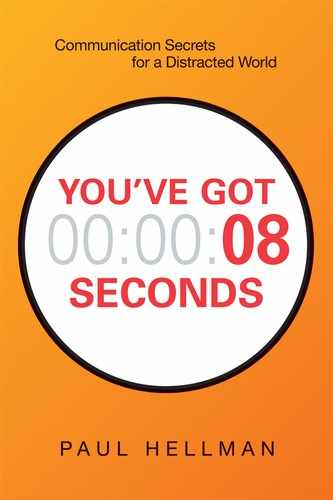|CHAPTER 6|
The Easiest Way to Explain Anything
“Analogies . . . make one feel more at home.”
Is Your Info Hard to Understand or to Picture? Try an Analogy
Let’s say you’re explaining something complicated, like the brain, to someone like me, whom you suspect may not have one.
Use an analogy.
The brain, you might say, is like a sponge (absorbs everything). Or a sieve (retains nothing). Or mush (seems to lack coherence).
You can easily picture a sponge, a sieve, or mush. A picture is no small thing. Most business info is abstract and hard to picture.
If your audience can’t visualize what you’re saying, they’re more likely to daydream. Daydreams are visual. For example, imagine being at the beach. Notice you can see the beach.
Analogies are visual too. (So are stories, plus other techniques that we’ll discuss shortly; please see sidebar on next page.)
We use analogies all the time, almost without thinking. Let’s say you go to a French restaurant, and your companion has never eaten frog’s legs. “Oh,” you say, “tastes just like chicken.”
An analogy is simply a comparison. Frog’s legs are like chicken. You explain the unknown, hard-to-picture X (e.g., frog’s legs) in terms of the known, easy-to-picture Y (chicken).
A lot of food tastes just like chicken. Often, that’s because it is chicken. The main purpose of chicken, I believe, is to explain every other food.

Give your audience a picture:
1. Analogies
2. Stories: page 59
3. Show vs. tell: page 99
4. Talking about food: page 105
Trying to Explain Your Job? Use an Analogy
Ever try to explain your job to someone outside your field? It’s almost impossible. Except for a few jobs on TV—doctor, lawyer, psychopath—no one really gets what anyone else does all day.
Your explanation sounds like this:
You: “I’m a technical, technical, technical. And what that means, basically, is that you’ll never understand my job. No one does. Most days, I don’t even understand it. My spouse has given up trying. She just tells people I’m a dental hygienist.”
Other person (trying to be polite): “Your job sounds very interesting.”
Here’s the problem: they can’t picture it. There are 12,000 occupations. Most are specialized and outside of everyday experience.
Solution? Use an analogy. Compare your complicated, hard-to-picture job with something that’s easy-to-picture.
For example:
![]() “I’m like a weatherman who has to predict the financial climate. I tell people that, sooner or later, it’s going to rain. I just have no idea when.” (Economic forecaster)
“I’m like a weatherman who has to predict the financial climate. I tell people that, sooner or later, it’s going to rain. I just have no idea when.” (Economic forecaster)
![]() “I’m like a lion tamer, except that I work with people.” (Executive coach)
“I’m like a lion tamer, except that I work with people.” (Executive coach)
![]() “I’m a psychiatrist for machines. Everyone calls me when their computer acts weird.” (IT support)
“I’m a psychiatrist for machines. Everyone calls me when their computer acts weird.” (IT support)
True, they still won’t remember most of what you say. But they’ll probably remember the image, and that means they’ll probably remember you.
So what’s your job like? Look for an image.
As for me: “I’m like a Brink’s truck. I help business leaders deliver risky messages.”
If, later today, you meet three other consultants who talk about biz communication, I’m betting that tomorrow, you’ll remember the truck.
Use an Analogy to Avoid the “Curse of Knowledge”
The more you know about something, the worse you are at explaining it.
That’s called the “curse of knowledge.”1 You forget what it’s like to start from zero, not knowing anything.
Suppose, for example, you had to explain the Internet to someone who’d been living in a cave. How would you do it?
“The Internet,” explains Wikipedia, “is the global system of interconnected computer networks that use the Internet protocol suite (TCP/IP) to link billions of devices worldwide.”
You have to admit, that’s amazing. The Internet, a complicated concept, is being explained by an even more complicated version of itself (the Internet protocol suite)—plus two acronyms (TCP/IP). You can smell the curse of knowledge.
Let’s try an analogy.
The Internet, I’d say, is like a library—it’s the best, worst, and strangest library ever imagined. (If we go back to chapter 2, library is the main message; best, worst, and strangest are three key points.)
Best library: You can get information about anything and everything, delivered in seconds to your own handheld gadget. And you can communicate with other users anywhere in the world.
Worst library: It’s indifferent to whether content is true or false, useful or vile.
Strangest library: There’s no mailing address, no building, no librarian. Where is it? The library doesn’t exist in a physical location, but in a twilight-zone non-location called cyberspace, which basically means “we have no idea.”
